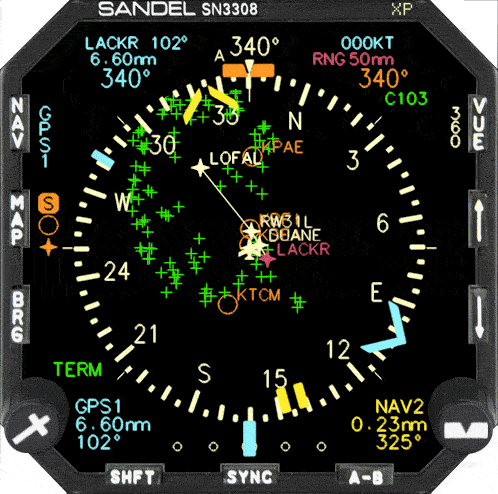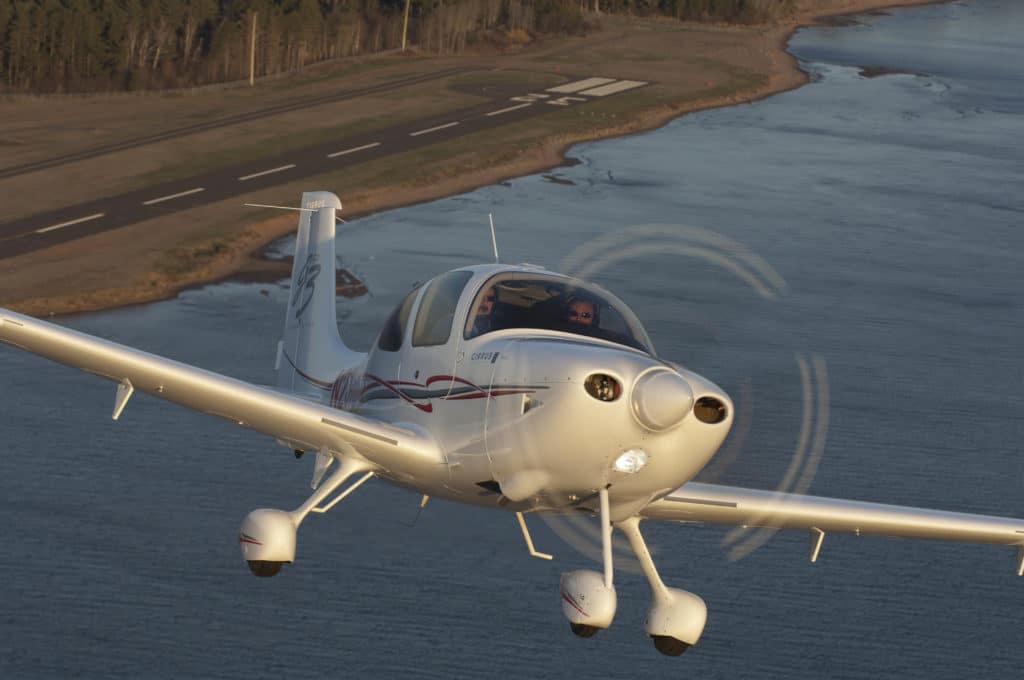When pilots screw up, plaintiff lawyers always seem to sue equipment manufacturers.
In June 2014, I posted an item to the AOPA Opinion Leaders Blog titled “The Dark Side of Maintenance.” It talked about what I refer to as “maintenance-induced failures” (or “MIFs” for short). In my blog post, I gave a bunch of examples of such MIFs—aircraft malfunctions that were the unintended result of errors during maintenance.
One of the examples I gave involved an early model Cirrus SR22 that was equipped with a Sandel SN3308 electronic horizontal situation indicator (EHSI). The Cirrus owner emailed me that he’d been plagued by intermittent heading errors on the EHSI. When I questioned the owner, I learned that he’d been suffering these problems for about three years, and that they started right after his shop performed the scheduled 200-hour replacement of the Sandel’s projector lamp. Coincidence?

I’d seen this exact same problem in my own Sandel-equipped Cessna 310. It’s invariably due to inadequate engagement between the connectors on the back of the instrument and the mating connectors in the mounting tray. It’s essential to slide the instrument into the tray just as far as possible before tightening the clamp. It’s a bit tricky to do, but if you don’t the stage is set for flaky, glitch-plagued operation of the instrument. I instructed the Cirrus owner how to re-rack the instrument, a five-minute procedure at most. Miraculously, his intermittents went away, as I knew they would.
About three months later, I received an email from an AOPA member in Kansas City, who said he read my blog post with interest, particularly the part about the Sandel EHSI rack engagement glitch. “I am the attorney for the mother of two deceased children who perished in a Cirrus crash,” he explained, and asked whether I’d be willing to provide expert consultation in the lawsuit. I replied that while I do quite a bit of expert consulting work in the field of aviation maintenance, it’s almost always defense work. I further explained that I regularly do air crash defense expert work for both Cirrus Aircraft and Continental Motors, so if either Cirrus or Continental were defendants in the lawsuit (as I suspected they were), I could not serve as an expert on behalf of the plaintiff. I figured that would be the end of our email exchange.
What happened?
Just out of curiosity, I searched the NTSB accident database and quickly located the factual and probable cause reports for the fatal accident in question. To make a long story short, the aircraft crashed while making an ILS approach at night in IMC conditions. The pilot’s flight instructor estimated that the pilot had about 1,000 hours total time, about 650 in type, and just 75 in actual IMC.
The pilot filed an IFR flight plan via DUATS, but there was no record of him obtaining a weather briefing either electronically or telephonically. The area forecast called for tops to 15,000 feet and the destination TAF forecast a 300-foot ceiling in mist and rain showers.

The crash occurred shortly after midnight, and it was pitch dark and moonless. Despite the fact that the AWOS was reporting a 700-foot ceiling and 8-mile visibility, the pilot missed his first attempt to shoot the ILS approach and asked ATC to be vectored for a second attempt. The controller instructed the pilot to turn left to a 360 heading and climb to 3,000 feet. One minute later, the pilot called ATC and said, “I need some help.” That was his last transmission.
Radar track data showed that after the missed approach, the aircraft turned left to maintain a ground track of about 065 while climbing to about 2,800 feet. The aircraft then entered another left turn and descended into the ground at about 6,000 feet/minute. The debris field extended less than 150 feet from the impact crater. The propeller exhibited S-bending and chordwise scratches, indicating the engine was making power at impact. Post-accident investigation of the airframe and engine revealed no evidence of pre-impact failure or malfunction. The Cirrus was equipped with a CAPS ballistic parachute system, but there was no indication that the pilot ever tried to activate it.
Whose fault?
Not surprisingly, the NTSB placed the blame for this accident squarely on the shoulders of the PIC. The Board’s probable cause determination read: “The pilot’s loss of airplane control as a result of spatial disorientation experienced in night instrument meteorological conditions.” That’s pretty much a no-brainer.
Something the NTSB didn’t say (but I will) is that if you shoot an ILS in night IMC and wind up going missed, attempting the approach a second time is a real sucker’s bet. The smart move is to divert to your alternate where the weather is decent, check into the local Motel 6, and lick your wounds. (With 45 years of serious weather flying under my belt, I’ve become a rather accomplished wound licker.)
Clearly, however, the plaintiff lawyer had a very different take on the situation. He was determined to convince a jury that it was the airplane’s fault—perhaps the fault of its Sandel EHSI that might not have been fully engaged in its mounting rack—and that Cirrus Aircraft and Sandel Avionics should be held financially responsible for the crash.
I don’t blame the attorney one bit. His job, after all, is to obtain as much monetary compensation as possible for his client, the poor mom who tragically lost two kids in the crash. Unless the deceased pilot was an extraordinarily high net worth individual, the only place that money could come from would be the hardware manufacturers (who carry lots of product liability insurance). That’s why whenever a plane crashes and people are seriously injured or killed, the manufacturers always get sued. Always. (Heck, that’s what keeps defense expert witnesses like me in business.)
No, I can’t blame the plaintiff lawyer for seeking redress from the manufacturers. But yet I can’t bring myself to help him in his quest, either. My sympathy for the mom, whose life is forever scarred by the tragic loss of her kids, doesn’t blind me to the fact that the real loser in these lawsuits isn’t the manufacturer defendants or their insurance companies—it’s us, the aircraft owners and pilots. The insurance companies pass the ridiculously high cost of defending and settling and even occasionally losing such lawsuits to the manufacturers in the form of punitively high insurance premiums. The manufacturers in turn pass the cost of those premiums on to us in the form of punitively high prices for aircraft, engines, propellers, avionics, instruments, and repair parts.
There’s no free lunch in aviation. And we’re the ones who always wind up picking up the check.
The NTSB investigators found no evidence of equipment failure. But for the sake of argument, let’s imagine for a moment that the plaintiff attorney was right and the Sandel EHSI went berserk at the worst possible moment. The way I look at it, instruments and avionics are fully expected to fail from time to time. That’s why our aircraft are required by regulation to be equipped with backup instruments, and why we spend so much time during initial and recurrent instrument training learning how to deal with such failures and practicing “partial panel” flying to keep our skills sharp for the day we might need them.
Seems to me that in cases like these, the buck still stops with the PIC. He’s supposed to be able to fly the aircraft even when instruments or avionics fail. He’s trained to do that. If he doesn’t prove to be up to that task, it’s wrong to blame the hardware.
I guess it’s a good thing I’m not a plaintiff lawyer. I’d make a terrible one.
Epilogue
Nine months after I told the plaintiff lawyer that I wouldn’t serve as an expert in his lawsuit, I received another email from him. This time, he was demanding that I submit to a deposition “as a fact witness” in the case, to testify as to my experience with the Sandel EHSI problems mentioned in my blog post, and to produce the work orders and maintenance records for the Cirrus aircraft mentioned in the blog. “Our case is in Missouri,” the lawyer said, “but we can have a subpoena issued out of a California court if necessary.” (I live in California.)
I emailed my own attorney. “Can he actually do that?” I asked. “Can he actually force me to testify in a lawsuit over a matter I had nothing to do with, against my will?” My attorney said that in fact the plaintiff lawyer probably could do it, although it would involve considerable hassle and expense.
“I have no interest in getting involved in this matter,” I emailed the plaintiff attorney. “I respectfully decline to be deposed in this matter unless compelled by law to do so. I honestly believe you’d be wasting time and effort seeking a subpoena compelling me to be deposed as a fact witness in this case simply because I have no relevant facts to offer. But of course that’s your decision, not mine.”
The attorney responded that he would start the wheels in motion to obtain a subpoena from a California court. Subsequently, he emailed me that a mediation had been scheduled in the case and if the mediation resulted in a resolution, my testimony would not be needed. The scheduled date of that mediation has now passed. Hopefully it was successful and the plaintiff lawyer will let me off his hook.
You bought a plane to fly it, not stress over maintenance.
At Savvy Aviation, we believe you shouldn’t have to navigate the complexities of aircraft maintenance alone. And you definitely shouldn’t be surprised when your shop’s invoice arrives.
Savvy Aviation isn’t a maintenance shop – we empower you with the knowledge and expert consultation you need to be in control of your own maintenance events – so your shop takes directives (not gives them). Whatever your maintenance needs, Savvy has a perfect plan for you: